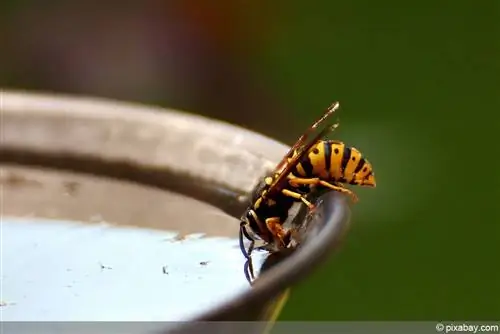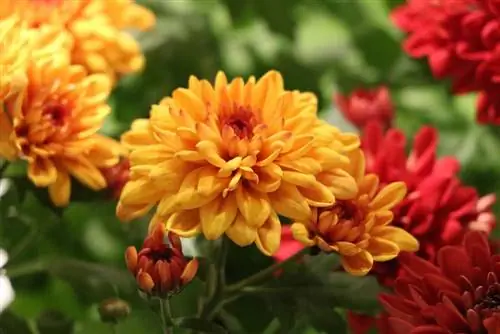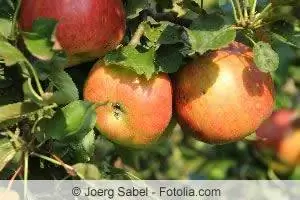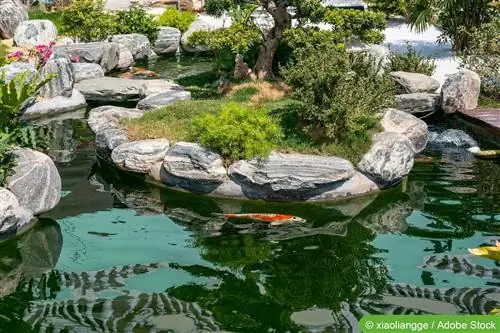- Author admin [email protected].
- Public 2023-12-17 03:39.
- Last modified 2025-06-01 06:48.
The kangaroo paw is a perennial herbaceous and upright growing plant with smooth leaves that form rosettes above the ground. When you look at the flowers, you notice the tubular shape with a crown that grows together at the top. In terms of color, a lot of things are possible, from different shades of yellow and orange to red nuances. The Australian iris, as the kangaroo plant is also called, blooms from May to July.
Profile
German names: kangaroo paw, kangaroo plant, kangaroo flower, Australian iris
English name: Kangaroo Paw
Botanical name: Anigozahnthos
Family: Haemodoraceae
Growth height: 40-60 cm
Growth width: 35-65 cm
Flower color: varies between yellow, orange and red
Flowering period: May-July
Location: sunny and warm
Soil: loose, permeable, lime-free, optimal mixture of potting soil and sand
Other: lime intolerant, not hardy, poisonous
Location
Given its tropical origins, it is not surprising that the kangaroo paw needs a sunny and warm place to thrive. It is best to offer it light partial shade - it promotes flower formation. But be careful: the location should not be too shady, otherwise the plant will not feel comfortable enough.
Tip:
Place your Anigozahnthos on the eastern or western windowsill. Such a place optimally meets the requirements of the kangaroo paw.
Important
- be sure to protect from drafts
- Avoid ambient temperatures below 8°C
As soon as the outside temperatures consistently exceed 10°C, you can bring the Anigozahnthos outdoors with a clear conscience. She finds good conditions on the bright balcony or terrace.
But: Rainy and correspondingly low-light summers are not really the right thing for exotic beauty. In such cases, it is advisable to bring the kangaroo paw into the house and use artificial plant spotlights from specialist retailers to ensure the plant receives the necessary light.
Substrate
The substrate of the kangaroo paw should be loose and permeable. It is also advisable to ensure that there is no limescale. If the lime content in the soil is too high, it is gradually deposited in the plant, which hinders the absorption of water and nutrients. As a result, the plant slowly dies.
Tip:
Do not use substrate from the garden. It's better to play it safe and buy potting soil and sand from a specialist store. A mixture of soil with small amounts of sand has proven successful. As an alternative to classic potting soil, you can also use bog soil or azalea substrate to cultivate the kangaroo plant.
Pouring
When it comes to the need for water, you shouldn't rely on the origin of the kangaroo's paw. Otherwise, it would be reasonable to assume that the plant would be able to cope with long periods of drought. However, this is not the case - on the contrary: in the main growing season, the Australian plant reacts extremely sensitively to a lack of water. That's why you should water your Anigozahnthos regularly:
- Always allow the top substrate layer to dry
- carry out finger test for investigation
- never use (very) hard water
- water only moderately in winter (see wintering)
- never water over flowers and leaves
Tip:
If possible, use rainwater from the barrel for watering. The sensitive kangaroo plant copes best with this.
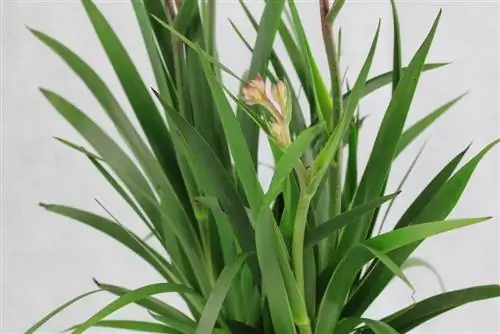
Waterlogging poses dangers for potted plants - the kangaroo paw is no exception. If the water cannot drain away properly, it is at risk of infestation with ascomycete fungi and, as a result, root rot. To prevent such a scenario, it makes sense to place a drainage at the bottom of the vessel.
How to do it:
- use robust and non-rotting materials
- for example small pottery shards and lava grit
- simple alternative: small pebbles
- Drainage layer with a height of approx. 3 cm is ideal
- Excess irrigation water drains away quickly
- Kangaroo paw doesn't get “wet feet”
Fertilize
The exotic plant depends on a sufficient supply of nutrients in order to grow and thrive. For this purpose, you should use lime-free liquid or slow-release fertilizer from specialist retailers. The product provides the plant with everything it needs.
Be careful
Too high a mineral concentration can also damage the anigozahnthos. So it's better to be economical and use a long-term fertilizer, which you apply once in a generally low dose before you leave the plant alone for the rest of the year. As far as the exact amount is concerned, follow the manufacturer's instructions.
Note:
Regardless of what type of fertilizer you ultimately use: stop using it by the end of August at the latest. At this time, the kangaroo paw is gradually preparing for winter. It would be unhe althy to then stimulate the plant to produce shoots again.
Cutting
The kangaroo paw can reach a maximum height of 60 centimeters. Do not underestimate the width of the plant - it reaches up to 65 centimeters. However, it is usually not necessary to shape or prune the plant.
Important
If you are not aiming to harvest kangaroo paw seeds, you should remove the wilted inflorescences early - that is, as soon as they are visibly "lifeless". The same principle also applies to old and dead shoots. Cut the latter close to the ground using sharp secateurs.
Tip:
Several Anigozahnthos species have a colorful, poisonous milky sap. It is therefore advisable to wear special gardening or other suitable work gloves when cutting for your own safety. After completing the work, you should clean the tools you used thoroughly.
Wintering
All varieties of kangaroo paw are not hardy. The plants must therefore be brought indoors as soon as the temperatures outdoors permanently fall below ten degrees Celsius.
The frost-proof quarters should have the following properties:
- no active radiators in the immediate vicinity
- bright location with as much light as possible
- Temperatures between 10°C and 14°C
- Substrate should never dry out completely
- still water the plant moderately and rarely
- Fertilization must be stopped completely
Start increasing the water supply gradually from the end of February. It is also important to gradually get the kangaroo paw used to the sunlight before it returns to its usual place on the balcony or terrace. It's best to give it a shady place where the sun only shines intermittently for the first week or two. How to prevent burns on the leaves of the plant.
Propagate
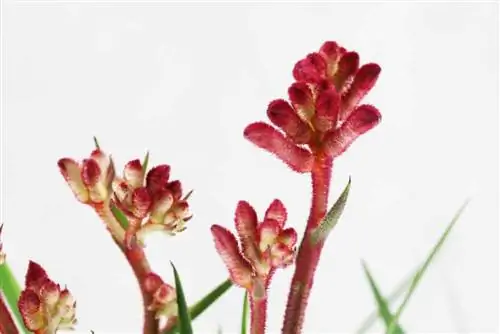
There are two ways to propagate Anigozahnthos:
- about root pieces
- through seeds
Propagation via root pieces
Vegetative propagation via root pieces is difficult and requires considerable effort. If you still want to try it, you should consider and implement the following aspects:
- Only divide older plants - and do so carefully.
- The time of division is the main growing season - before the plant prepares for winter.
- Use a sharp garden knife to divide.
Important
Due to the small rootstock of the kangaroo paw, it is hardly possible to obtain several pieces at once. Either way, you should only remove a few pieces so as not to weaken the plant unnecessarily.
Note:
The rhizome pieces do not require any special treatment. They are planted as usual in a suitable substrate. The latter must be kept evenly moist. The shoots develop roots within two to four weeks.
Propagation by seeds
You are definitely making the better decision by propagating by seeds. This form is much easier to implement. Anigozahnthos seeds are rarely found in local garden centers. If you want to reproduce the plant by sowing, you should get the seeds from your own crop.
How it works:
1. Step: DO NOT cut off the withered flowers, but let them grow into seeds.
2. Step: Sow the collected seeds quickly, because old seeds germinate poorly.
3. Step: Choose a shallow growing container for the seeds and fill it with lean substrate.
4. Step: Place the seeds on the soil and press them lightly.
Important:
Do not press the seeds too hard or put soil on them.
Kangaroo paws are among the light germinators. This means that the seeds need proximity to light in order to develop.
5. Step: Moisten the soil with a water sprayer.
6. Step: Place the container with the seeds in a warm and bright place.
Tip:
During the day the temperature should be around 18 to 22 degrees Celsius, at night it can drop to up to 13 degrees Celsius.
The following things should be taken into account during the germination period:
- no direct sunlight for the seeds
- Avoid waterlogging
- BUT: Do not let the substrate dry out
After around 21 to 28 days, the first shoot tips will appear - provided you follow the procedure described. Prick out the young seedlings as soon as they have developed at least two pairs of leaves. They can then be moved into separate pots.
Plants
The Australian exotic plant is not suitable for long-term cultivation in ornamental beds. Instead, it is recommended to move the plant in the pot outdoors after the ice saints. To do this, you should choose a sufficiently large container so that the roots of the kangaroo paw have enough space. Repotting is necessary approximately every two to three years. Replace the old substrate with fresh, humus-rich soil.
Tip:
You can encourage the kangaroo paw to flower with a simple trick: Before moving it outdoors, expose the plant to a constant ambient temperature of around ten to 14 degrees Celsius for around five weeks.
Diseases and pests
The most important disease is root rot, which can occur when waterlogging occurs. However, it can be easily avoided by adequate watering and creating drainage in the pot.
When it comes to pests, aphids and spider mites are the biggest pests. They like to suck out the plant's cell sap. Older kangaroo paws are less likely to be affected - and if they are, they can cope with the infestation as long as it is eliminated in the foreseeable future. In the case of young plants or those weakened by care errors, effective countermeasures must be taken very quickly.
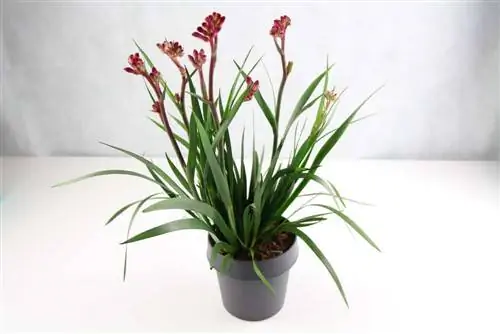
Aphids can generally be recognized by their sticky excreta, spider mites typically by their silvery, shimmering webs.
Information and recommendations for destroying or repelling insects:
- Spider mites do not tolerate high humidity
- Pouring with diluted decoction of nettles works
- Wipe severely affected shoots regularly with a damp cloth
- Setting up sticky traps against aphids
There are also natural methods to combat pests. Release animal predators near your exotic plant. These include parasitic wasps, ladybird larvae, predatory mites and lacewing larvae. You can order the insects in special online shops. If you own a natural garden, you probably don't need to buy the predators separately. The beneficial insects automatically settle in such areas and thus help to eliminate the unwanted pests.
Conclusion
The kangaroo paw is a special ornamental plant from Australia. To cultivate them successfully, you need sensitivity, attention and a little perseverance. The effort is relatively high. Experience in dealing with exotic plants helps the plant lover, but even beginners who have a certain passion for gardening can get along with the perennial.



